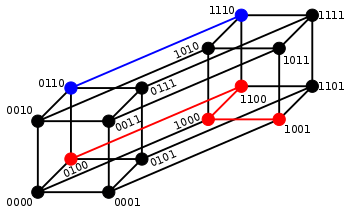Hamming distance: Difference between revisions
m robot Adding: cs:Hammingova vzdálenost |
|||
| Line 25: | Line 25: | ||
==History and applications== |
==History and applications== |
||
The Hamming distance is named after [[Richard Hamming]], who introduced it in his fundamental paper about ''error-detecting and error-correcting codes'' (1950). It is used in [[telecommunication]] to count the number of flipped bits in a fixed-length binary word as an estimate of error, and therefore is sometimes called the '''signal distance'''. Hamming weight analysis of bits is used in several disciplines including [[information theory]], [[coding theory]], and [[cryptography]]. However, for comparing strings of different lengths, or strings where not just substitutions but also insertions or deletions have to be expected, a more sophisticated metric like the [[Levenshtein distance]] is more appropriate. |
The Hamming distance is named after [[Richard Hamming]], who introduced it in his fundamental paper about ''error-detecting and error-correcting codes'' (1950) introducing [[Hamming code]]s. It is used in [[telecommunication]] to count the number of flipped bits in a fixed-length binary word as an estimate of error, and therefore is sometimes called the '''signal distance'''. Hamming weight analysis of bits is used in several disciplines including [[information theory]], [[coding theory]], and [[cryptography]]. However, for comparing strings of different lengths, or strings where not just substitutions but also insertions or deletions have to be expected, a more sophisticated metric like the [[Levenshtein distance]] is more appropriate. |
||
== Algorithm example == |
== Algorithm example == |
||
Revision as of 02:15, 12 October 2007
 |
 |
 |
 |
In information theory, the Hamming distance between two strings of equal length is the number of positions for which the corresponding symbols are different. Put another way, it measures the minimum number of substitutions required to change one into the other, or the number of errors that transformed one string into the other.
Examples
The Hamming distance between:
- 1011101 and 1001001 is 2.
- 2143896 and 2233796 is 3.
- "toned" and "roses" is 3.
Special properties
For a fixed length n, the Hamming distance is a metric on the vector space of the words of that length, as it obviously fulfills the conditions of non-negativity, identity of indiscernibles and symmetry, and it can be shown easily by complete induction that it satisfies the triangle inequality as well. The Hamming distance between two words a and b can also be seen as the Hamming weight of a−b for an appropriate choice of the − operator.
For binary strings a and b the Hamming distance is equivalent to the number of ones in a xor b. The metric space of length-n binary strings, with the Hamming distance, is known as the Hamming cube; it is equivalent as a metric space to the set of distances between vertices in a hypercube graph. One can also view a binary string of length n as a vector in by treating each symbol in the string as a real coordinate; with this embedding, the strings form the vertices of an n-dimensional hypercube, and the Hamming distance of the strings is equivalent to the Manhattan distance between the vertices.
History and applications
The Hamming distance is named after Richard Hamming, who introduced it in his fundamental paper about error-detecting and error-correcting codes (1950) introducing Hamming codes. It is used in telecommunication to count the number of flipped bits in a fixed-length binary word as an estimate of error, and therefore is sometimes called the signal distance. Hamming weight analysis of bits is used in several disciplines including information theory, coding theory, and cryptography. However, for comparing strings of different lengths, or strings where not just substitutions but also insertions or deletions have to be expected, a more sophisticated metric like the Levenshtein distance is more appropriate.
Algorithm example
The Python function hamdist() computes the Hamming distance between
two strings (or "sequential objects" mapped into strings) of equal length.
def hamdist(s1, s2):
assert len(s1) == len(s2)
return sum(ch1 != ch2 for ch1, ch2 in zip(s1, s2))
The following C++ function will compute the Hamming distance of two integers (considered as binary values, that is, as sequences of bits). The running time of this procedure is proportional to the Hamming distance rather than to the number of bits in the inputs.
int hamdist(int x, int y)
{
int dist = 0, val = x^y;
while(val)
{
++dist;
val &= val - 1;
}
return dist;
}
References
Adapted in part from Federal Standard 1037C.
Richard W. Hamming. Error Detecting and Error Correcting Codes, Bell System Technical Journal 26(2):147-160, 1950.
See also
- Hamming weight
- Jaccard index
- Levenshtein distance (aka “edit distance”), a generalization of the Hamming distance
- Manhattan distance
- Similarity (mathematics)
- Similarity space on Numerical taxonomy

